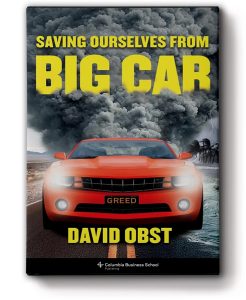Columbia Business School Publishing
Review by Brian Tanguay

When I lived in Tokyo many years ago, my street was just wide enough for two vehicles to pass within inches of one another. Parking on the street was prohibited, and none of the old houses had garages. Owning and operating a car in Japan at that time was a luxury. Fortunately, using a combination of bicycle, bus, train, or subway, one could efficiently and cheaply get anywhere one wanted to go. Every time I purchase new tires or replace a major component in one of our old cars, I think very fondly of my days in Japan.
In most cities and towns in the United States a car is a necessity, and this results from design rather than accident. We are a car culture as David Obst points out in Saving Ourselves from Big Car, and our dependence on cars is contributing to a global climate crisis that can’t be mitigated with the same ideas and inventions that created it. If you have ever sat in bumper-to-bumper traffic and wondered at all the time and money wasted, or threw up your hands after spending forty-five minutes to travel less than a mile, or lamented the rudimentary state of mass transit, this book provides context and offers some solutions.
“One out of every six people in the United States,” writes Obst, “makes a living by manufacturing, distributing, or servicing our cars. A full one-quarter of America’s retail trade is car-based.” It’s both astonishing and sobering to stop and think about the many ways the automobile transformed our society, from road building to architecture to the mythical idea of the Great American Open Road to advertising. Before owning a car became commonplace, houses weren’t built with garages, and huge areas in our cities weren’t devoted to parking lots; parking meters were unknown. By the same token, there was no need for motels, motor courts, drive-in theaters, car washes, or professional auto mechanics; traffic engineers and suburbs were yet to exist.
Early roads were often rutted, pot-holed, and prone to flooding. Poor road conditions and cars without safety features led to accidents which were often fatal, but potential death didn’t dissuade the public from buying cars. Obst provides a brief history of the Ford Motor Company and General Motors, showing how these companies both supported and benefitted from the explosion of road building after World War II. The federal government got into the transportation game in a big way when the Eisenhower administration proposed, and Congress passed, The National System of Interstate and Defense Highways Act, which included some forty thousand miles of new, uniform roads from one end of the nation to the other. As Obst writes, “Within a generation, America went from being a country full of two-lane roads, often unpaved, to a place connected by new multi-lane paved freeways and highways…”
The frenzy of road and highway building had economic as well as social consequences. As a uniform system of roads expanded, trucking supplanted railroads as the primary way to move goods. Road building not only transformed rural areas, it also impacted inner cities, where construction of highways, overpasses and cloverleafs often required the displacement of residents, many of them poor black and brown people. In the hands of city planners and traffic engineers, eminent domain is a powerful tool.
Obst writes clearly, conversationally, and passionately about his subject. Despite the uphill nature of the task, he remains reasonably optimistic that we can mitigate the damage caused by car culture. Ideas such as Mobility as a Service (MaaS) are gaining traction as more and more people realize the cost of operating cars, the time wasted in snarled traffic, and the blight of urban congestion. From Portland, Oregon to Taipei, Taiwan, people and local governments are waking up to the true costs of designing our lives and communities around cars. As David Obst sees it, “We must start thinking of Big Car as if it were a cancer trying to destroy us.”
